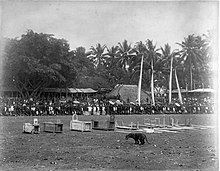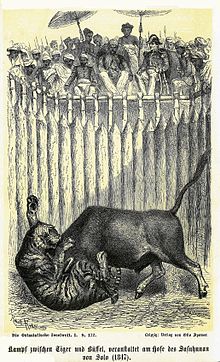Rampokan was a traditional Javan big cat fight. Panthers or tigers were released from wooden boxes and surrounded by warriors with lances trying to prevent them from breaking out of the circle. The rampokan would take place towards the end of Ramadan. It symbolized purification and the overcoming of evil.[1] If the tigers and panthers succeeded in breaking through the circle, it was seen as an omen of disaster as famine.[citation needed] The ritual died out in the early 20th century.[2] A battle between a tiger and buffalo was the first part of the event in its earlier incarnations, but in later years this was omitted.[1]
A Javan tiger killed along with seven leopards during Rampokan in Kediri, East Java, circa 1900.
See also
editReferences
edit- ^ a b Wessing, Robert (1992). "A Tiger in the Heart: the Javanese Rampok Macan". Bijdragen tot de Taal-, Land- en Volkenkunde. KITLV. pp. 287–308. Retrieved 5 December 2015 – via https://www.academia.edu/5407176/A_Tiger_in_the_Heart_the_Javanese_Rampok_Macan.
{{cite web}}: External link in|via= - ^ Fengshui in China: Geomantic Divination Between State Orthodoxy and Popular Religion Ole Bruun, University of Hawaii Press, 2003 pages 242, 243



